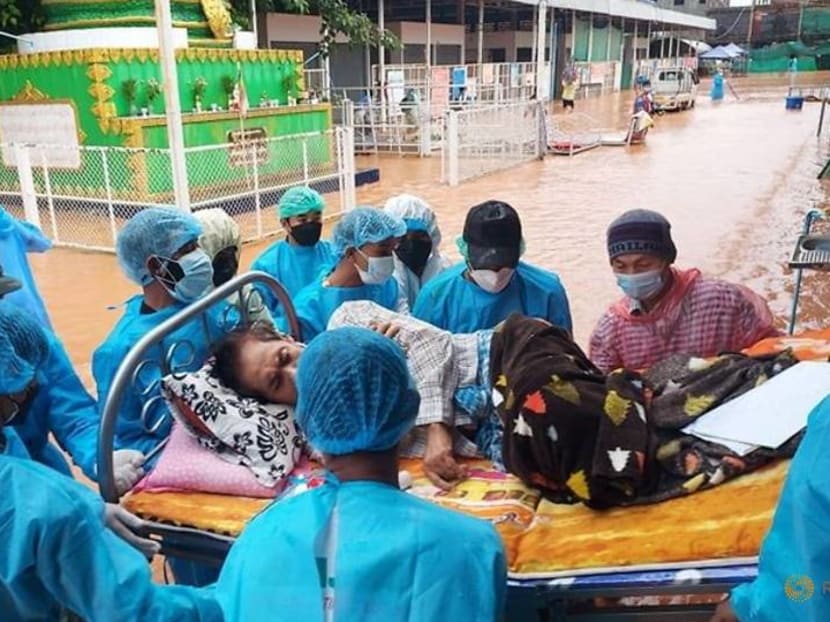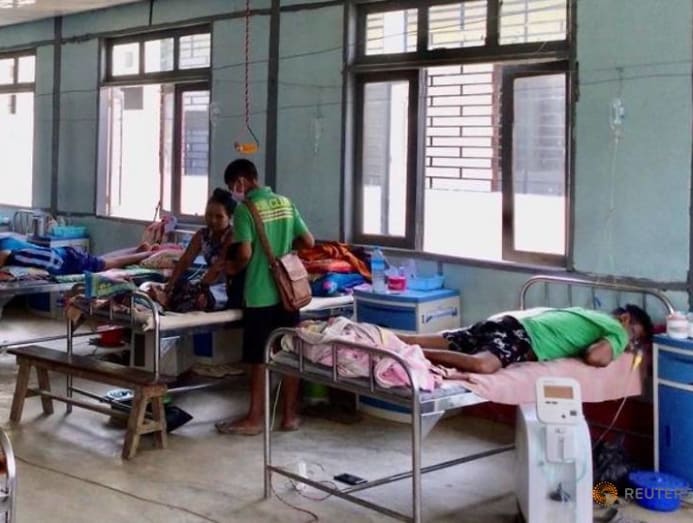Commentary: Myanmar is turning into a super-spreader COVID-19 state
A mismanagement of the crisis and a collapsing health sector is imposing unspeakable suffering on the poor, say two observers.

Volunteers in protective suits carry a COVID-19 patient lying on a hospital bed following floods, in Myawaddy, Myanmar. (Photo: Karen Information Center via Reuters)
ADELAIDE: Myanmar is facing a catastrophic health crisis that could have ramifications not just for the country’s long-suffering people, but across the region as well.
The country is experiencing a major spike in COVID-19 cases — what one Doctors Without Borders official referred to as “uncontrolled community spread” — fuelled by the military junta’s gross mismanagement of the crisis and a collapsing health sector.
The military regime’s official statistics are running at around 6,000 cases and 300 deaths per day, but no one believes these are accurate. This is, after all, the junta that staged a military coup in February and then tried to argue it was constitutionally valid.
With only 2.8 per cent of Myanmar’s 54 million people fully vaccinated, there are now concerns the country could become a “COVID-19 super-spreader state”. And this could lead to the emergence of new variants, says the UN’s special rapporteur for human rights in Myanmar who said:
“This is very, very dangerous for all kinds of reasons … This is a region that is susceptible to even greater suffering as a result of Myanmar becoming a super-spreader state.”
READ: Commentary: How India’s COVID-19 story went from humanitarian crisis to managed calm
DOCTORS IMPRISONED
The UN says a “perfect storm” of factors is fuelling the deepening health crisis. Medical staff have been on strike as part of the civil disobedience movement against the coup.
Oxygen and other medical equipment are increasingly expensive and in short supply. Even getting an oxygen concentrator into Myanmar is not straightforward, though Singapore said this week it will rush 200 machines into the country.

Reliable figures on the infection rate are impossible to obtain, but civil society groups that assist with cremations and funeral services in Yangon say they are seeing up to 1,000 uncounted COVID-19 deaths a day in that city alone. The national total may be several thousand per day.
One reason it’s impossible to get an accurate count of cases is the extremely low rate of testing. There are only around 15,000 COVID-19 tests being conducted per day in a country of 54 million people. The tests are, however, returning a positive rate of around 37 per cent, or 370 positives for every 1,000 tests.
It’s also believed nearly 50 prisoners at the crowded, notorious Insein Prison are now infected.
These prisoners include top leaders from Aung San Suu Kyi’s National League for Democracy, doctors connected with the civil disobedience movement, and foreigners like Australian academic Sean Turnell, an adviser to Suu Kyi who was arrested by the junta after the coup.
READ: Commentary: Should the UK recognise a new Myanmar diplomat appointed by the junta?
Another adviser and lawyer to Suu Kyi, Nyan Win, died last week after being infected with COVID-19 at Insein.
THE POOR ARE SUFFERING
Such a catastrophic health situation is exacerbating Myanmar’s inequalities. Poorer people are less able to socially distance and less likely to get tested and receive meaningful treatment. They suffer invisibly, often in silence.
In a report published this week, the World Bank estimated Myanmar’s economy would contract by 18 per cent this year due to the effects of the pandemic and the coup. The share of people living in poverty is also likely to more than double by the beginning of 2022, compared to 2019.
The ethnic minority regions of the country may well be disproportionately suffering, too. Since the coup, conflicts have intensified across the country between the military and the ethnic armed organisations and pro-democracy advocates that have joined them, causing immense social dislocation.
READ: Commentary: Why are Chinese troops assembling on the Myanmar border?
The UN refugee agency estimates 200,000 people were internally displaced from February to June, bringing the total of displaced people in the country to 680,000. These marginalised groups are even less likely to have access to medical treatment.
These figures are also not taking into account the refugees outside the country, such as the million Rohingya languishing in the cramped refugee camps in Bangladesh. The Bangladesh government has said it will begin vaccinating the Rohingya next month.
(Why not allow dining in for those vaccinated when MICE and other big events can continue? Public health experts discuss whether new rules in Singapore mean prior plans to live normally with COVID-19 will shift on this week’s Heart of the Matter podcast.)
INTERNATIONAL AID DESPERATELY NEEDED
When Cyclone Nargis killed 140,000 people in Myanmar in 2008, the country’s previous military regime received wide-ranging offers of assistance from ASEAN, the regional bloc, and the wider international community.
But since the coup, Western aid to Myanmar has been redirected through non-government groups, causing hold-ups. The UN says the junta has also yet to account for US$350 million in COVID-19 aid the International Monetary Fund sent to Myanmar just days before the coup in February.
READ: Commentary: Defiance in Myanmar’s diplomatic ranks threatens the military’s power
READ: Commentary: Has Myanmar coup sparked rethinking on non-interference among ASEAN countries?
The country hasn’t received vaccine doses since May, though China pledged to send 6 million doses by August, with the first batch arriving last week. China may end up being the most proactive donor, since it is worried about an outbreak along its shared border with Myanmar.
Optimists say this may be a time for reconciliation and for everyone in Myanmar to unite against the common enemy of COVID-19. Yet it is hard to imagine that happening right now, when the military’s own mishandling of the pandemic has generated so much outrage from the population.

What can be done? Perhaps Australia, which we are told is “awash” in AstraZeneca vaccines, could make rapid moves to send desperately needed supplies to Myanmar via its non-government partners. It would be a bold and impressive diplomatic move.
There is then the need for the international community to confront the Myanmar generals for their appalling mishandling of the country since the coup. By seizing control from elected leaders, they have impoverished their own people, sparked new conflicts and exacerbated the damage done by a global pandemic.
The heartbreaking reality is the people of Myanmar have been left without the prospect of significant relief at the worst possible time.
BOOKMARK THIS: Our comprehensive coverage of the COVID-19 pandemic and its developments
Download our app or subscribe to our Telegram channel for the latest updates on the coronavirus outbreak: https://cna.asia/telegram
Adam Simpson is Senior Lecturer, University of South Australia. Nicholas Farrelly is Professor and Head of Social Sciences, University of Tasmania. This commentary first appeared in The Conversation.





